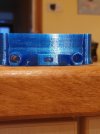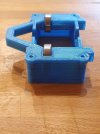DGE-Railroad
The Orchard Line
I've tried my first printing in petg last night. I've printed exclusively PLA until now.
I use Simplify3d as my slicer/controller and a Creality 3D printer.
The prints have come out pretty well all things considered, but I can't seem to eliminate the warping
The piece seems to adhere to the bed okay; ive tried using both a glue stick and painters tape with the same results.
No raft,
240c hotend
60c 1st layer / 55c bed
0 cooling 1st layer / 100%
The part is 100% infill and 5 solid top/bottom layers because it needs to be as strong as possible.
Everything else (speeds, retraction,etc) are the standard PLA ones
Any other suggestions for where I need to look to sort out the warping? Turn off the fan for the bottom few layers? Increase the bed temp?


I use Simplify3d as my slicer/controller and a Creality 3D printer.
The prints have come out pretty well all things considered, but I can't seem to eliminate the warping
The piece seems to adhere to the bed okay; ive tried using both a glue stick and painters tape with the same results.
No raft,
240c hotend
60c 1st layer / 55c bed
0 cooling 1st layer / 100%
The part is 100% infill and 5 solid top/bottom layers because it needs to be as strong as possible.
Everything else (speeds, retraction,etc) are the standard PLA ones
Any other suggestions for where I need to look to sort out the warping? Turn off the fan for the bottom few layers? Increase the bed temp?




